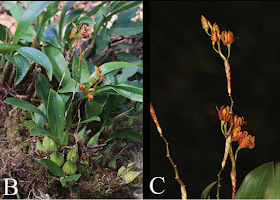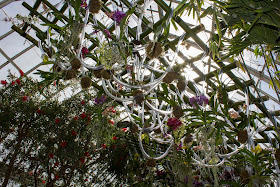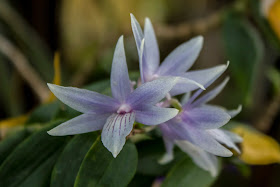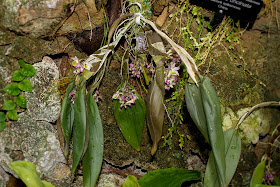June has been a great month for new orchid species discoveries. Check out these cool new flowers!
Odontochilus putaoensis
This terrestrial orchid was discovered in northern Myanmar by a group of botanists from the Chinese Academy of Sciences. The orchid has greenish-brown flowers that are about 1cm across. |
| Odontochilus putaoensis
Image credit: Aung et al, Phytokeys 2018
|
 |
| Odontochilus putaoensis closeup
Image credit: Aung et al, Phytokeys 2018
|
- Authors: Ye Lwin Aung, Aye Thin Mu, Xiaohua Lin
- Published in: Phytokeys, 2018
- Odontochilus putaoensis (Cranichideae, Orchidaceae), a new species from Myanmar
Pleurothallis hawkingii
This is a epiphytic orchid from Costa Rica blooms with pale yellow to white flowers, which sometimes have a distinctive purplish hue. It was described by a pair of botanists from the Universidad de Costa Rica.
 |
| Pleurothallis hawkingii
Image credit: Adam Karremans and Jose Esteban Jimenez Phytotaxa 2018
|
 |
| Pleurothallis hawkingii
Image credit: Adam Karremans and Jose Esteban Jimenez, Phytotaxa 2018
|
 |
| Pleurothallis hawkingii purple variant
Image credit: Adam Karremans and Jose Esteban Jimenez, Phytotaxa 2018
|
- Authors: Adam Karremans and Jose Esteban Jimenez
- Published in: Phytotaxa, 2018
- Pleurothallis hawkingii and Pleurothallis vide-vallis (Orchidaceae; Epidendroideae), two new species from Cordillera de Guanacaste in Costa Rica
Pleurothallis vide-vallis
Another Costa Rican Pleurothallis species described in the same paper as P. hawkingii, Pleurothallis vide-vallis is a small epiphytic species that blooms with yellow flowers that have ranging degrees of pink hues.
 |
| Pleurothallis vide-vallis
Image credit: Adam Karremans and Jose Esteban Jimenez, Phytotaxa 2018
|
 |
| Pleurothallis vide-vallis closeups of yellow and purple variants
Image credit: Adam Karremans and Jose Esteban Jimenez, Phytotaxa 2018
|
- Authors: Adam Karremans and Jose Esteban Jimenez
- Published in: Phytotaxa, 2018
- Pleurothallis hawkingii and Pleurothallis vide-vallis (Orchidaceae; Epidendroideae), two new species from Cordillera de Guanacaste in Costa Rica
Gastrodia kachinensis
Gastrodia are a genus of parasitic orchids, which grow primarily underground. They have no leaves, do not photosynthesize, and instead feed on the fungi that grow around their roots. Gastrodia kachinensis is a new species discovered in Myanmar by a pair of botanists from the Chinese Academy of Sciences.
 |
| Left: A Gastrodia kachinensis inflorescencees, barely visible against the forest floor. Right: closeup of G. kachinensis
Image credit: Ye Lwin Aung and Xiao-hua Jin, Phytokeys 2018
|
- Authors: Ye Lwin Aung and Xiao-hua Jin
- Published in: Phytokeys, 2018
- Gastrodia kachinensis (Orchidaceae), a new species from Myanmar



















































